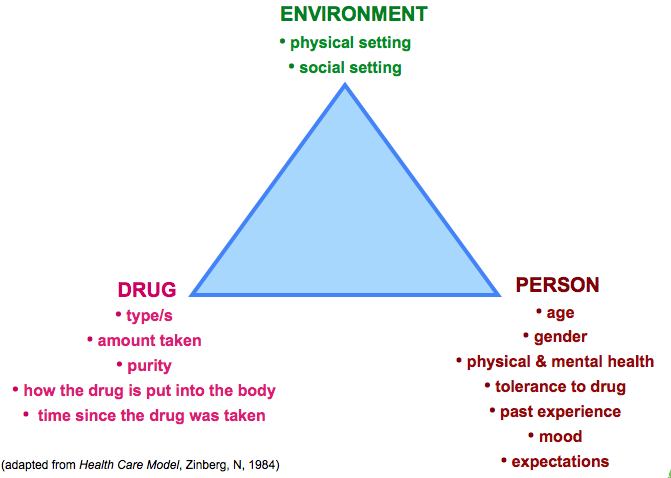The effects of psychoactive substances on the Central Nervous System and the effects seen in the user are often two very different things (Clarke et al, 2003). There is no certainty that the same drug will facilitate the same effects in different individuals.
Other factors or variables that may influence the effects of psychoactive substances that should be taken into consideration by the practitioner are described below.

The drug
Patterns of use
- how much does the individual use on each occasion?
- how often does the individual use?
- when does the individual use?
- how does the individual use or what is the preferred route of administration for the drug/s
- are other drugs being used in combination or to ameliorate withdrawal symptoms
The individual
- the age, gender, weight and general health of the individual and how might this interact with the type of substance being used
- the individual’s tolerance and previous experience of the substance including intoxication, after effects and withdrawal
- the individual’s past experience, expectations, beliefs about the drug
- the current mood and psychological health of the individual and how might substance use impact on this
The environment in which a drug is used
- in what social settings and company does the individual uses drugs and how safe is this?
- what is the context of the individual’s use including patterns of drug use according to ritual or culture (NCETA, 2004).
Route of administration
- onset (how soon are the drugs are felt?)
- intensity (how strong are the effects?)
- duration (how long do the effects of the drug last?) (Clarke et al, 2003)
Poly drug use
- Poly drug use or the mixing of two or more psychoactive substances that are capable of interacting is often unpredictable (more details on the next page...)
Other factors
It may be that on occasion a person may present as substance-affected, however it is important not to assume this is the case as there can be other factors which cause the presentation. For example:
- Head injuries
- Acquired brain injury (ABI)
- Diabetes
- Epilepsy
- Physical disability
- Intellectual disability
- Mental Illness
This module continues in the next page...
